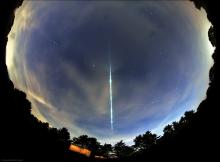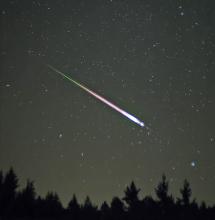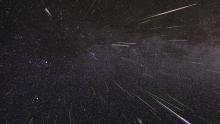Listen to today's episode of StarDate on the web the same day it airs in high-quality streaming audio without any extra ads or announcements. Choose a $8 one-month pass, or listen every day for a year for just $30.
You are here
Orionid Meteors
A meteor shower will be at its best this weekend. The Moon makes a pest of itself, though, especially on Sunday night, when the shower should reach its peak. It leaves a little better viewing window tonight and tomorrow night, though. And this is a shower that stretches things out a bit — the number of “shooting stars” stays near the peak for several nights in a row.
The Orionid shower is the offspring of Halley’s Comet. As the comet orbits the Sun, it sheds bits of dust and rock. Earth flies through clumps of this debris in May and October. Some of it slams into Earth’s atmosphere at high speeds, vaporizing as glowing streaks of light.
The Orionids get their name from the point where they appear to enter the atmosphere — Orion the hunter. The constellation climbs into view by about 1 a.m. You don’t have to look at Orion to see the meteors, though — they can streak across any part of the sky.
The shower is expected to reach its peak in the wee hours of Monday morning. By then, the Moon will be almost full, so it will overpower most of the meteors. And it won’t set until about 90 minutes before dawn.
But it sets a couple of hours earlier than that tonight, and about one hour earlier tomorrow night. And it won’t be as full. Since the shower stays fairly steady for several nights — perhaps a dozen or more meteors per hour — that makes the early part of the weekend a slightly better time to watch for the Orionid meteors.
Script by Damond Benningfield






